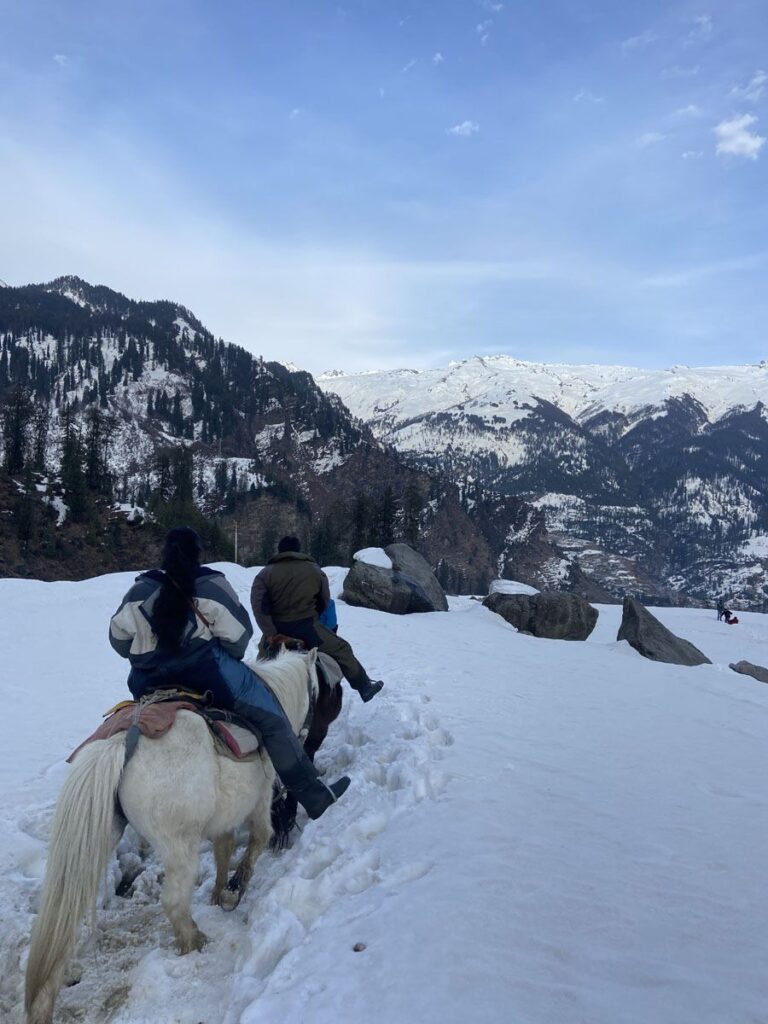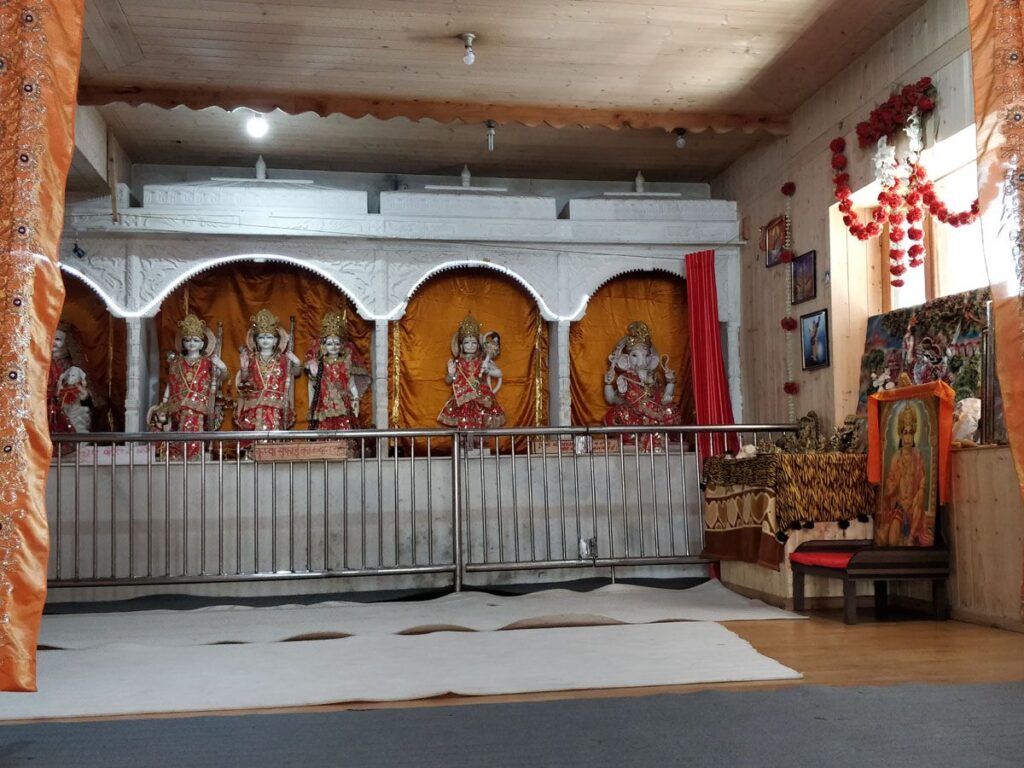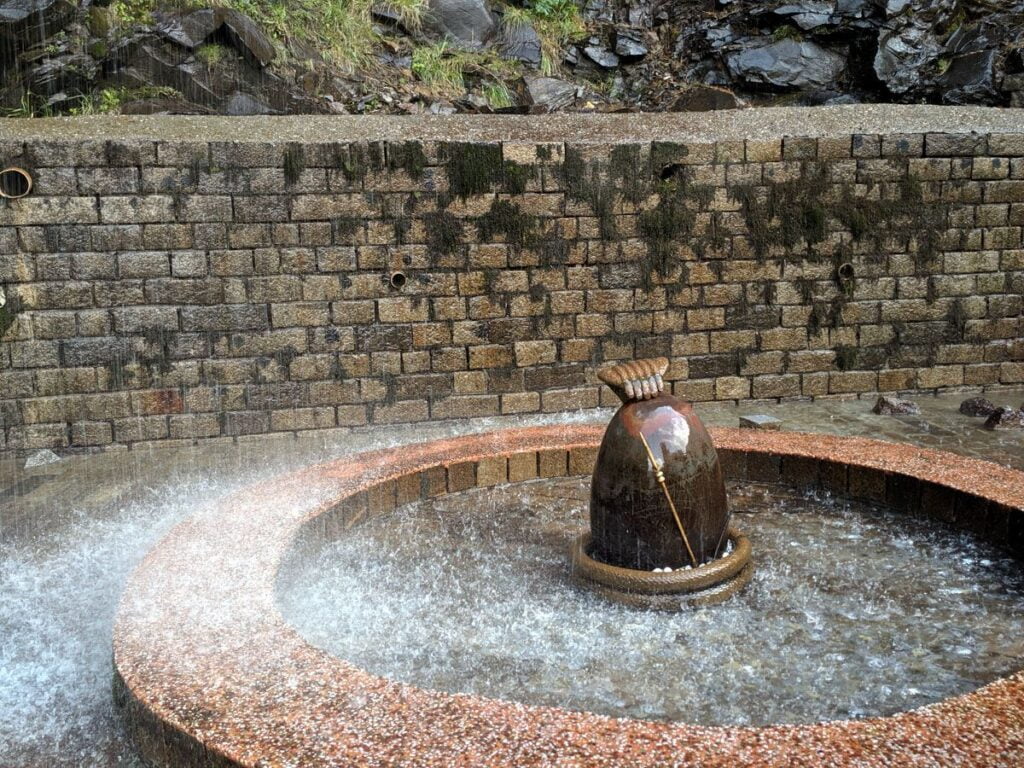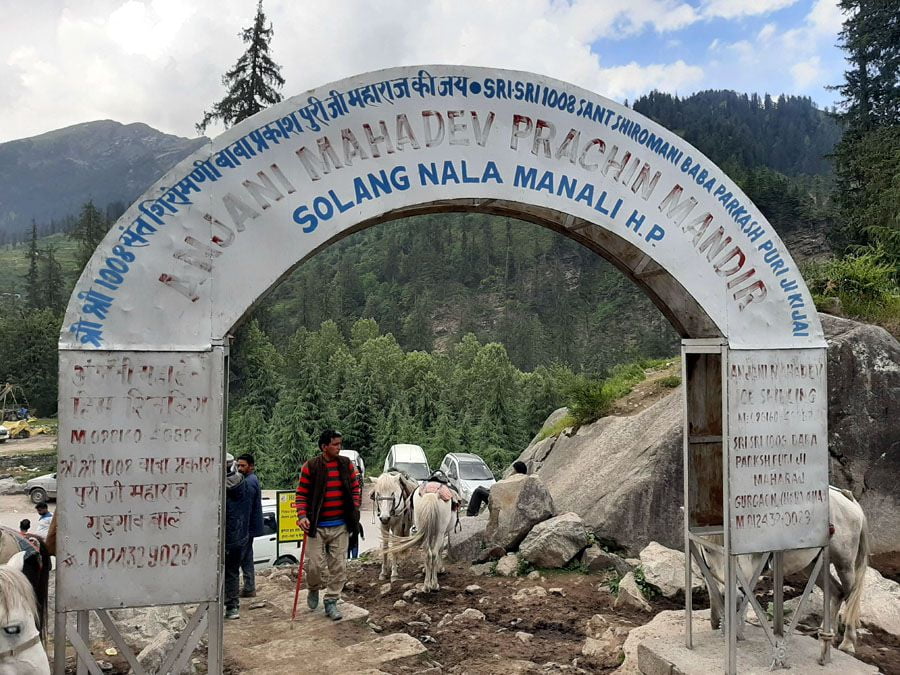Anjani Mahadev Temple: Waterfall on Shivling
Anjani Mahadev Temple is a Hindu temple located in the Solang Valley in Himachal Pradesh, India. The temple is dedicated to Lord Shiva, and is known for its unique natural phenomenon, a Shivlinga formed by a waterfall.

Contents
Anjani Mahadev Temple History:
Mythological Origins:
The temple’s name is deeply intertwined with the epic Hindu Ramayana. Legend has it that Anjani, the mother of the mighty Hanuman, practiced intense meditation and penance at this very spot to seek the blessings of Lord Shiva. Pleased by her devotion, Lord Shiva manifested himself before her. The temple’s location, amidst the cascading waterfalls and snow-capped peaks, is believed to be the very place where this divine encounter occurred.
The Enchanting Ice Lingam:
Adding to the temple’s mystique is the natural phenomenon of the “Ice Lingam.” During the winter months, when temperatures plummet, the cascading waterfall above the temple freezes, forming a towering ice stalagmite that takes on the shape of a Shivalinga, the symbolic representation of Lord Shiva. This natural ice sculpture is considered a sacred manifestation of the deity, attracting devotees and tourists alike.
Modern Discovery and Development:
While the temple’s origins are shrouded in ancient legends, its modern revival is attributed to Guru Baba Prakash Puri Ji Maharaj in the late 20th century. Guided by a divine vision, Baba Prakash Puri discovered the natural Shivalinga and established the temple around it. He also identified a cave near the temple steps as the place where Anjani practiced her penance, naming it the “Anjani Cave.”
A Trek Through Nature’s Splendor:
Reaching the Anjani Mahadev Temple is a journey in itself. A scenic trek through the Solang Valley takes you past gushing streams, verdant meadows, and snow-capped mountains, culminating in the temple’s serene embrace. The trek offers breathtaking views of the surrounding landscape, making it a rewarding experience for both spiritual seekers and nature enthusiasts.
A Testament to Faith and Nature:
The Anjani Mahadev Temple stands as a testament to the enduring power of faith and the beauty of nature. It is a place where ancient mythology intertwines with the wonders of the natural world, offering a unique spiritual experience for all who visit.
Read More>> Sacred Kashi Vishwanath Temple: 11th Jyotirling of Liberation

Legend of Anjani Mahadev Temple:
The legend of Anjani Mahadev Temple is associated with the Hindu deity Hanuman. Anjani was the mother of Hanuman, and she is said to have meditated at this spot in order to conceive a son. Please see the image of Anjani Mahadev Temple, Manali
According to the legend, Anjani was a devout woman who had been childless for many years. She prayed to Lord Shiva for a son, and he granted her wish. Anjani then went to this spot in the Solang Valley of Himachal Pradesh and meditated for many years. During her meditation, she received a vision of Lord Shiva, who told her that she would soon conceive a son.
Anjani eventually gave birth to Hanuman, who became one of the most important figures in Hindu mythology. Hanuman is known for his strength, courage, and devotion to Lord Rama. He is also considered to be the protector of mankind.
Read More>> Katyayani Shakti Peeth Vrindavan
Myths and Beliefs of Anjani Mahadev Temple:
The Birthplace of Hanuman: According to Hindu mythology, the Anjani Mahadev Temple is the birthplace of Hanuman, the Hindu monkey god and a central figure in the Ramayana epic. It is believed that Anjana, the mother of Hanuman, gave birth to him under a holy fig tree here. The temple complex houses a sanctum dedicated to Anjana, and a small shrine marks the spot where Hanuman is said to have been born.
Lord Shiva’s Blessings: The temple is also dedicated to Lord Shiva, the father of Hanuman. It is believed that Lord Shiva blessed Anjana with a powerful son after she performed intense penance here. Devotees often visit the temple to seek blessings for progeny, good health, and success.
The Power of the Holy Fig Tree: The holy fig tree under which Hanuman is said to have been born is considered a sacred site. Devotees tie sacred threads (kalava) around the tree to make wishes and offer prayers. The leaves of the tree are also believed to have medicinal properties.
The Sacred Pond: The temple complex also houses a sacred pond known as the Anjani Kund. It is believed that taking a dip in the pond can cure ailments and bring good luck. Devotees often offer prayers and perform rituals at the kund.
Abode of Miracles: The Anjani Mahadev Temple is known for its miraculous powers. Devotees believe that their prayers are answered here and that the temple has the power to heal the sick and grant wishes. Many stories of miracles and answered prayers are associated with the temple.
Read More>> Madmaheshwar Temple: Dedicated to Lord Shiva’s Belly Button

Significance of Anjani Mahadev Temple:
Religious Significance:
- Shiva Linga: The temple houses a unique 20-foot-tall ice Shiva Linga that forms naturally during winter when a waterfall freezes over it. This phenomenon is revered as a miracle and draws devotees seeking blessings from Lord Shiva.
- Anjani’s Meditation Site: Legend has it that Anjani, the mother of Lord Hanuman, meditated at this very spot to seek Lord Shiva’s darshan. Hence, the temple’s name. This association imbues the site with immense spiritual significance for devotees of Hanuman. Amarnath of Himachal Pradesh: Devotees often refer to Anjani Mahadev Temple as the “Amarnath of Himachal Pradesh” due to the presence of the natural ice Shiva Linga, similar to the one found in the Amarnath Cave in Jammu and Kashmir.
Historical Significance:
- Ancient Cave: A cave at the foot of the steps leading to the temple is believed to be where Baba Prakash Puri, who discovered the ice Shiva Linga, used to meditate. This adds a layer of historical intrigue to the site.
- Recent Discovery: The natural ice Shiva Linga was only discovered in the late 20th century, adding a sense of novelty and wonder to the temple’s appeal.
Geographical Significance:
- Scenic Trek: The trek to the Anjani Mahadev Temple, winding through the Solang Valley amidst stunning Himalayan landscapes, is a popular attraction in itself. The journey offers breathtaking views and a sense of adventure.
- Location: Situated in the picturesque Solang Valley near Manali, the temple’s location adds to its allure. Manali is a renowned tourist destination, and the temple acts as a spiritual and adventurous retreat within its vicinity.
Read More>> Panch Kedar Yatra: Ultimate Travel Guide to 5 Divine Shiv Temples

Places to visit near Anjani Mahadev Temple:
- Manali: A popular hill station known for its scenic beauty, Manali offers various activities such as trekking, paragliding, and visits to attractions like Hadimba Devi Temple and Manu Temple.
- Solang Valley: Known for its picturesque landscapes, Solang Valley is a great place for adventure sports like skiing, paragliding, and zorbing, especially during the winter months.
- Rohtang Pass: If accessible, Rohtang Pass is a high mountain pass offering breathtaking views of the Himalayas and opportunities for snow activities.
- Old Manali: Explore the charming Old Manali village with its narrow lanes, traditional houses, and vibrant cafes. It provides a more serene and laid-back atmosphere compared to the bustling main town.
- Kullu Valley: The Kullu Valley is known for its lush greenery, apple orchards, and the Beas River. You can visit the Raghunath Temple and experience the local culture.
- Naggar Castle: Located near Manali, Naggar Castle is a historical castle with stunning architecture and panoramic views of the surrounding mountains.
- Jana Waterfall: If you enjoy nature walks, you might want to visit Jana Waterfall, a scenic spot near Naggar.
- Great Himalayan National Park: This UNESCO World Heritage Site offers trekking opportunities amid pristine natural beauty.

FAQ:
Q: What is the Anjani Mahadev Temple?
The Anjani Mahadev Temple is a Hindu temple dedicated to Lord Shiva, located in the Solang Valley, Manali, Himachal Pradesh, India. The temple is known for its natural waterfall, which flows directly over a Shiva lingam.
Q: Who is the main deity worshipped at the Anjani Mahadev Temple?
The main deity worshipped at the Anjani Mahadev Temple is Lord Shiva, in the form of a Shiva lingam. The temple is named after Anjani, the mother of Hanuman, who is believed to have worshipped Lord Shiva at this site.
Q: What is the significance of the Anjani Mahadev Temple?
The Anjani Mahadev Temple is a popular pilgrimage site for Hindus, especially during the summers. Devotees believe that praying at the temple brings blessings, prosperity, and good health. The temple is also known for its scenic beauty, offering stunning views of the Solang Valley.
Q: How can I reach the Anjani Mahadev Temple?
The Anjani Mahadev Temple is located approximately 1.5 kilometers from Solang Valley. You can reach the temple by walking, taking a taxi, or riding a horse. There is also a zip line that takes you to the top of the hill where the temple is located.
Q: What are the timings of the Anjani Mahadev Temple?
The Anjani Mahadev Temple is open from 6:00 AM to 9:00 PM every day. The temple performs aartis (prayer ceremonies) throughout the day, including:
- Morning Aarti: 6:30 AM
- Evening Aarti: 6:30 PM
Q: Are there any special events or festivals at the Anjani Mahadev Temple?
The Anjani Mahadev Temple celebrates several special events and festivals throughout the year, including:
- Mahashivratri: The night of Lord Shiva’s wedding to Parvati is one of the most important festivals celebrated at the temple. Lakhs of devotees visit the temple on this day to offer prayers and seek blessings.
- Mondays: Mondays are dedicated to Lord Shiva, and the temple sees a large number of devotees on this day.
Q: What are some interesting facts about the Anjani Mahadev Temple?
- The Anjani Mahadev Temple is one of the most popular tourist destinations in Manali.
- The waterfall that flows over the Shiva lingam is said to be sacred, and devotees believe that bathing in the water can cleanse them of their sins.
- The temple is located at an altitude of 2,300 meters above sea level, offering stunning views of the Solang Valley.
Q: Which shivling has a waterfall in Himachal?
The shivling that has a waterfall in Himachal is located at the Anjani Mahadev Temple in Solang Valley, Manali. The waterfall flows directly over the shivling, creating a mesmerizing and sacred sight. This unique natural phenomenon attracts many devotees and tourists seeking blessings and a breathtaking experience.
Here are some additional details about the Anjani Mahadev Temple:
- Location: Solang Valley, Manali, Himachal Pradesh, India
- Altitude: 2,300 meters above sea level
- Significance: Dedicated to Lord Shiva, popular pilgrimage site, scenic beauty
- Highlights: Waterfall falling over shivling, panoramic views of Solang Valley
- Timings: Open from 6:00 AM to 9:00 PM, with aartis throughout the day

How to reach Anjani Mahadev Temple:
- Reach Manali:
- If you are traveling by air, the nearest airport is Bhuntar Airport (Kullu-Manali Airport).
- If you are traveling by road, Manali is well-connected by road from major cities in North India.
- Travel to Solang Valley:
- Anjani Mahadev Temple is located near Solang Valley, which is about 14 kilometers from Manali.
- You can hire a taxi or use local transportation to reach Solang Valley from Manali.
- Trek to Anjani Mahadev Temple:
- The temple is not directly accessible by road, and you’ll need to trek to reach the Anjani Mahadev Temple from Solang Valley.
- The trek is approximately 2-3 hours, depending on your pace and the trail conditions.
- Guides and Local Assistance:
- It’s advisable to hire a local guide or take help from locals who are familiar with the trekking route to ensure a safe journey.
- Check Weather Conditions:
- Be sure to check the weather conditions before starting your trek, as the region can experience snowfall and harsh weather, especially during winters.
- Carry Essentials:
- Wear appropriate trekking gear and carry essentials like water, snacks, a first aid kit, and any other necessary items.
